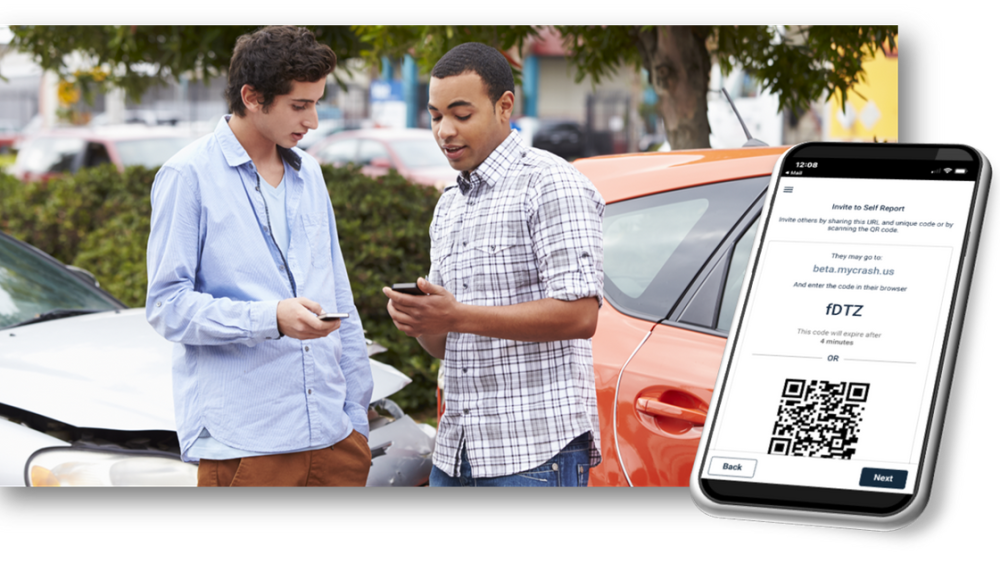In today’s landscape of short-staffed and underfunded police departments, exploring every efficiency possible is a high priority for many agencies. While some aspects of law enforcement are only so adaptable, new technology can transform manual and often outdated processes to bring agencies a range of benefits.
One such area that can be dramatically improved upon is police response to minor vehicle crashes. Many agencies still process these events using handwritten forms, which often leads to inaccurate and illegible documentation, and delays citizens’ ability to get information quickly. It’s a headache for records clerks as well, who manually enter information to create a digital record.
Instead of these time-consuming measures, agencies can increase efficiency and accuracy from start to finish using CARFAX Driver Exchange. This tool streamlines the process of collecting driver information and documenting crash details, freeing up agency resources for other, higher-priority incidents, or providing an advance digital response while the officer is on the way to the scene.
HOW CARFAX DRIVER EXCHANGE WORKS
Unlike manually filling out paperwork, CARFAX Driver Exchange allows agencies to send a secure link to drivers, enabling secure collection and distribution of driver and crash information directly from the scene. As a cloud-based solution, it can be used on any device, including desktops, tablets, smartphones and MDTs.
After a crash, drivers’ licenses, registration cards and vehicle identification numbers (VINs) can be scanned and used to auto-populate the Driver Exchange, eliminating the need for paper and pen. GPS and touch diagrams help involved parties quickly document exactly what occurred, and drop-down menus walk parties through the information exchange process easily.
CARFAX Driver Exchange assists officers by helping to clear crash scenes faster, creating better citizen customer service, reducing the time spent processing reports and providing multiple response scenarios that suit each agency’s needs.
YOU CHOOSE HOW TO RESPOND
Departmental policy varies when it comes to responding to minor vehicle crashes. While some agencies may not send an officer to a crash scene at all, others may mandate a response due to agency policy.
CARFAX Driver Exchange gives officers more control and flexibility over how and when to respond with four different response scenarios:
1. OFFICER-OPERATED REPORTING
Agencies that prioritize responding to minor vehicle crashes use CARFAX Driver Exchange to help facilitate driver information exchange and clear a scene faster. Using a mobile device, an officer scans drivers’ licenses and VINs in a few minutes, populating an error-free digital record that is delivered to citizens quickly and easily.
2. OFFICER-GUIDED REPORTING
Investigating and clearing a crash scene takes time, let alone having to manually fill out an accident report. With CARFAX Driver Exchange, citizens begin to exchange their information on their mobile devices while the officer works to get traffic flowing. Simply send all involved parties a secure link that walks them through the process step by step.
3. CITIZEN SELF-REPORTING
Agencies that do not respond to minor crashes or that are not able to get to the scene can still use CARFAX Driver Exchange to help citizens involved in minor vehicle crashes. Agencies send a link to the involved parties via mobile device, allowing them to exchange the information without even being physically present.
4. REMOTE-START REPORTING
If your agency does respond to minor vehicle crashes yet places a lower priority on them, citizens may be waiting at a scene for an officer to arrive before exchanging any information. If an officer can’t get to the scene right away, involved parties begin the exchange process using CARFAX Driver Exchange. Upon arrival, the officer completes and sends the information directly to the parties from the scene.
BENEFITS ALL AROUND
Using CARFAX Driver Exchange alleviates time spent filling out paperwork and helps lighten the load for understaffed agencies. It also benefits citizens.
Getting into a minor vehicle crash is enough to dampen anyone’s day, and drivers are often anxious to complete the necessary paperwork so that they can get an insurance claim started. CARFAX Driver Exchange delivers better citizen customer service as it gets them the information they need delivered via text or email and gets them back in their vehicles and on to what’s next in their day.
Also, by completing the driver information exchange process more efficiently, both officers and citizens spend less time at an accident scene, improving safety by reducing the risk of a secondary accident.
Now more than ever, people are concerned about their privacy, and CARFAX Driver Exchange works to keep an individual’s data secure.
When officers use their mobile devices at a crash scene, citizens can rest assured their personal information is not being stored. CARFAX Driver Exchange is cloud-based, and any links sent to drivers come from the agency, not from the individual officer.
CARFAX Driver Exchange goes a step further when it comes to privacy with a built-in tool that allows citizen information to be redacted based on each individual’s preference.
Far too many agencies don’t have the resources to respond to minor vehicle crashes and support their citizens in those times of need. With CARFAX Driver Exchange, the process of reporting these accidents is now far easier for all involved.
Visit CARFAX for Police for more information.
Read next: Spotlight: CARFAX digital tools are available to law enforcement agencies for free




